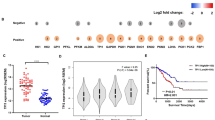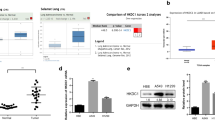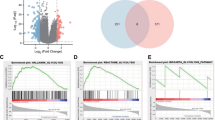Abstract
Glycolysis is a shared feature in various cancers including lung adenocarcinoma (LUAD). Testis Expressed 19 (TEX19) is correlated with cancer progression. But its effect on LUAD remains an unanswered question. The focus of our study was primarily to investigate how TEX19 works exactly in LUAD. We first downloaded mRNA data from TCGA-LUAD and performed differential expression analysis. Then, we performed a Kaplan–Meier analysis to analyze the relationship between mRNA expression and patients’ prognoses. hTFtarget database was utilized for the prediction of upstream transcription factors of mRNA. Next, qRT-PCR was employed for detecting TEX19 and Forkhead box A1 (FOXA1) expression. Western blot was adopted to detect the expression of glycolysis-related proteins. We also used CCK-8, colony formation, and flow cytometry assays to detect cell viability, proliferation, and apoptosis. Seahorse XF Extracellular Flux Analyzers were introduced to analyze extracellular acidification rate (ECAR) and oxygen consumption rate (OCR). Detection kits were used to detect pyruvate, lactate, citric acid, and malic acid. TEX19 was highly expressed in LUAD tissues. Real-time quantitative PCR (qRT-PCR) assay showed that TEX19 was significantly overexpressed in LUAD cell lines compared with normal bronchial epithelial cells BEAS-2B. Knockdown of TEX19 remarkably inhibited cell activity and proliferation, and promoted cell apoptosis, TEX19 was enriched in the glycolytic pathway. Meanwhile, the knockdown of TEX19 significantly hampered the contents of pyruvate, lactate, citric acid, and malic acid. The bioinformatics analysis, dual luciferase reporter experiment, and chromatin immunoprecipitation (ChIP) assay showed that FOXA1 was bound with TEX19. FOXA1 had a high expression level in LUAD. The rescue assay demonstrated that FOXA1, by activating TEX19 expression, enhanced glycolysis and proliferation and inhibited apoptosis of LUAD cells. In summary, FOXA1 promoted glycolysis and proliferation of LUAD cells by activating TEX19. This result can provide a theoretical basis for future research on LUAD.





Similar content being viewed by others
Data Availability
The datasets generated and analyzed during the current study are not publicly available, but are available from the corresponding author on reasonable request.
References
Sung, H., et al. (2021). Global Cancer Statistics 2020: GLOBOCAN estimates of incidence and mortality worldwide for 36 cancers in 185 countries. CA: A Cancer Journal for Clinicians, 71, 209–249. https://doi.org/10.3322/caac.21660
Li, Y., et al. (2021). RNA m(6)A reader YTHDF2 facilitates lung adenocarcinoma cell proliferation and metastasis by targeting the AXIN1/Wnt/beta-catenin signaling. Cell Death and Disease, 12, 479. https://doi.org/10.1038/s41419-021-03763-z
Liu, X. S., et al. (2021). NPM1 is a prognostic biomarker involved in immune infiltration of lung adenocarcinoma and associated with m6A modification and glycolysis. Frontiers in Immunology, 12, 724741. https://doi.org/10.3389/fimmu.2021.724741
Nooreldeen, R., & Bach, H. (2021). Current and future development in lung cancer diagnosis. International Journal of Molecular Sciences. https://doi.org/10.3390/ijms22168661
Duma, N., Santana-Davila, R., & Molina, J. R. (2019). Non-small cell lung cancer: Epidemiology, screening, diagnosis, and treatment. Mayo Clinic Proceedings, 94, 1623–1640. https://doi.org/10.1016/j.mayocp.2019.01.013
Park, J. H., Pyun, W. Y., & Park, H. W. (2020). Cancer metabolism: Phenotype, signaling and therapeutic targets. Cells. https://doi.org/10.3390/cells9102308
Li, X. B., Gu, J. D., & Zhou, Q. H. (2015). Review of aerobic glycolysis and its key enzymes—New targets for lung cancer therapy. Thoracic Cancer, 6, 17–24. https://doi.org/10.1111/1759-7714.12148
Hanahan, D., & Weinberg, R. A. (2011). Hallmarks of cancer: The next generation. Cell, 144, 646–674. https://doi.org/10.1016/j.cell.2011.02.013
Vander Heiden, M. G., Cantley, L. C., & Thompson, C. B. (2009). Understanding the Warburg effect: The metabolic requirements of cell proliferation. Science (New York, NY), 324, 1029–1033. https://doi.org/10.1126/science.1160809
Zhao, S., et al. (2021). LncRNA MIR17HG promotes colorectal cancer liver metastasis by mediating a glycolysis-associated positive feedback circuit. Oncogene, 40, 4709–4724. https://doi.org/10.1038/s41388-021-01859-6
Li, M., et al. (2021). RSL3 enhances the antitumor effect of cisplatin on prostate cancer cells via causing glycolysis dysfunction. Biochemical Pharmacology, 192, 114741. https://doi.org/10.1016/j.bcp.2021.114741
Hu, Y., Mu, H., & Deng, Z. (2021). The transcription factor TEAD4 enhances lung adenocarcinoma progression through enhancing PKM2 mediated glycolysis. Cell Biology International, 45, 2063–2073. https://doi.org/10.1002/cbin.11654
Kim, J. H., et al. (2018). Enhanced glycolysis supports cell survival in EGFR-mutant lung adenocarcinoma by inhibiting autophagy-mediated EGFR degradation. Cancer Research, 78, 4482–4496. https://doi.org/10.1158/0008-5472.CAN-18-0117
Planells-Palop, V., et al. (2017). Human germ/stem cell-specific gene TEX19 influences cancer cell proliferation and cancer prognosis. Molecular Cancer, 16, 84. https://doi.org/10.1186/s12943-017-0653-4
Xu, Z., et al. (2020). TEX19 promotes ovarian carcinoma progression and is a potential target for epitope vaccine immunotherapy. Life Science, 241, 117171. https://doi.org/10.1016/j.lfs.2019.117171
Blum, A., Wang, P., & Zenklusen, J. C. (2018). SnapShot: TCGA-analyzed tumors. Cell, 173, 530. https://doi.org/10.1016/j.cell.2018.03.059
Huang, et al. (2022). Cancer-cell-derived GABA promotes beta-catenin-mediated tumour growth and immunosuppression. Nature Cell Biology, 24, 230–241. https://doi.org/10.1038/s41556-021-00820-9
Zhang, Y., Wang, F., Chen, G., He, R., & Yang, L. (2019). LncRNA MALAT1 promotes osteoarthritis by modulating miR-150-5p/AKT3 axis. Cell and Bioscience, 9, 54. https://doi.org/10.1186/s13578-019-0302-2
Hu, Q., et al. (2019). UHRF1 promotes aerobic glycolysis and proliferation via suppression of SIRT4 in pancreatic cancer. Cancer Letters, 452, 226–236. https://doi.org/10.1016/j.canlet.2019.03.024
Tang, Y., et al. (2018). Overexpression of PCK1 gene antagonizes hepatocellular carcinoma through the activation of gluconeogenesis and suppression of glycolysis pathways. Cellular Physiology and Biochemistry, 47, 344–355. https://doi.org/10.1159/000489811
Zhou, J., et al. (2019). CircRNA-ENO1 promoted glycolysis and tumor progression in lung adenocarcinoma through upregulating its host gene ENO1. Cell Death and Disease, 10, 885. https://doi.org/10.1038/s41419-019-2127-7
Zhao, X., Wu, X., Wang, H., Yu, H., & Wang, J. (2020). USP53 promotes apoptosis and inhibits glycolysis in lung adenocarcinoma through FKBP51-AKT1 signaling. Molecular Carcinogenesis, 59, 1000–1011. https://doi.org/10.1002/mc.23230
Zhao, P., Zhou, M., Chen, R., & Su, R. (2020). Suppressed, “Warburg effect” in nasopharyngeal carcinoma via the inhibition of pyruvate kinase type M2-mediated energy generation pathway. Technology in Cancer Research and Treatment, 19, 1533033820945804. https://doi.org/10.1177/1533033820945804
Cai, X., et al. (2017). Expression of HMGB2 indicates worse survival of patients and is required for the maintenance of Warburg effect in pancreatic cancer. Acta Biochimica et Biophysica Sinica (Shanghai), 49, 119–127. https://doi.org/10.1093/abbs/gmw124
Liang, Y., et al. (2020). Corrigendum to “A novel long non-coding RNA LINC00355 promotes proliferation of lung adenocarcinoma cells by down-regulating miR-195 and up-regulating the expression of CCNE1” [Cell Signal 66:109462 (2020 Feb). https://doi.org/10.1016/j.cellsig.2019.109462]. Cellular Signalling, 73, 10975. https://doi.org/10.1016/j.cellsig.2020.109715
Yu, Y., Wang, Z., Zheng, Q., & Li, J. (2021). GREB1L overexpression correlates with prognosis and immune cell infiltration in lung adenocarcinoma. Science and Reports, 11, 13281. https://doi.org/10.1038/s41598-021-92695-x
Zhong, J., et al. (2016). Testis expressed 19 is a novel cancer-testis antigen expressed in bladder cancer. Tumour Biology, 37, 7757–7765. https://doi.org/10.1007/s13277-015-4567-8
Teng, M., Zhou, S., Cai, C., Lupien, M., & He, H. H. (2021). Pioneer of prostate cancer: Past, present and the future of FOXA1. Protein and Cell, 12, 29–38. https://doi.org/10.1007/s13238-020-00786-8
Dai, Y., et al. (2021). Expression of FOXA1 gene regulates the proliferation and invasion of human gastric cancer cells. Cellular and Molecular Biology, 67, 161–165. https://doi.org/10.14715/cmb/2021.67.2.25
Liu, J., et al. (2019). Circ-SERPINE2 promotes the development of gastric carcinoma by sponging miR-375 and modulating YWHAZ. Cell Proliferation, 52, e12648. https://doi.org/10.1111/cpr.12648
Funding
No funding.
Author information
Authors and Affiliations
Contributions
(I) Conception and design: YZ. (II) Administrative support: YF, LC. (III) Provision of study materials or patients: YF. (IV) Collection and assembly of data: HS. (V) Data analysis and interpretation: HS, YF. (VI) Manuscript writing: YZ. (VII) Final approval of manuscript: All authors.
Corresponding author
Ethics declarations
Conflict of interest
The authors report no conflict of interest.
Ethical Approval
Our study did not require an ethical board approval because it did not contain human or animal trials.
Additional information
Publisher's Note
Springer Nature remains neutral with regard to jurisdictional claims in published maps and institutional affiliations.
Rights and permissions
Springer Nature or its licensor (e.g. a society or other partner) holds exclusive rights to this article under a publishing agreement with the author(s) or other rightsholder(s); author self-archiving of the accepted manuscript version of this article is solely governed by the terms of such publishing agreement and applicable law.
About this article
Cite this article
Zhang, Y., Sheng, H., Fu, Y. et al. Transcription Factor FOXA1 Facilitates Glycolysis and Proliferation of Lung Adenocarcinoma via Activation of TEX19. Mol Biotechnol (2023). https://doi.org/10.1007/s12033-023-00848-2
Received:
Accepted:
Published:
DOI: https://doi.org/10.1007/s12033-023-00848-2




